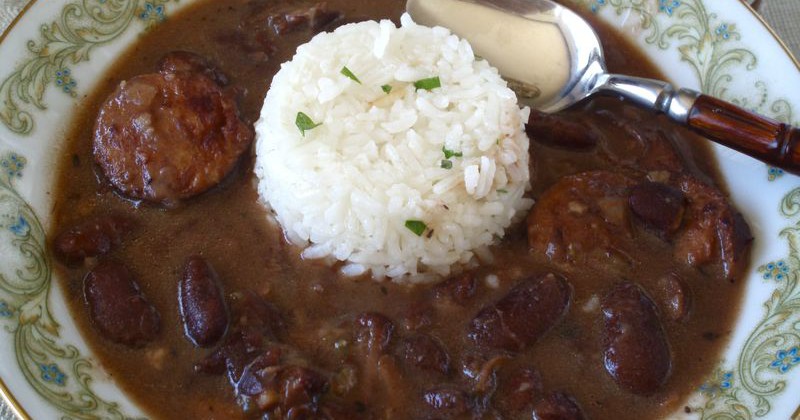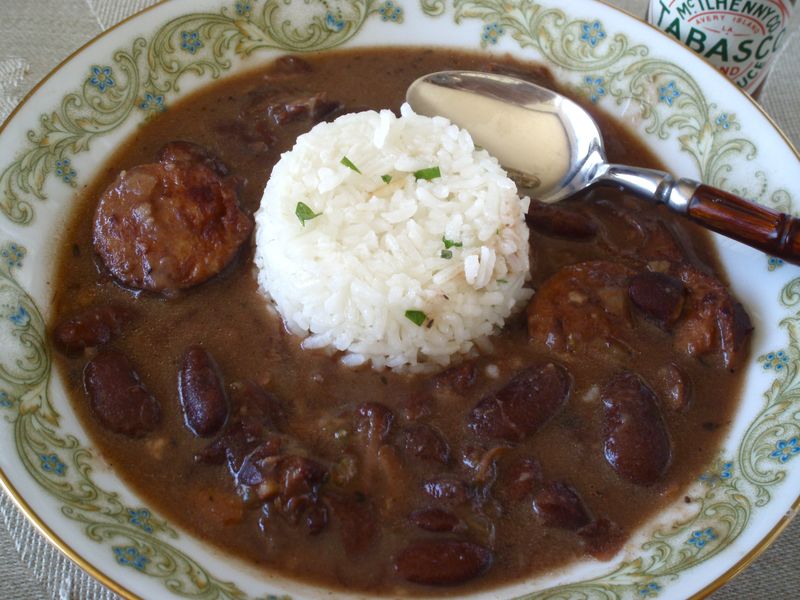Five Years after Katrina- Hungry Town and Red Beans and Rice
The central premise of Tom Fitzmorris’s Hungry Town: A Culinary History of New Orleans, the City Where Food Is Almost Everything, the recently released memoir with recipes, is that the force which pulled New Orleans together after the catastrophic flooding post-Katrina, was the city’s love of food. Fitzmorris is the host of a long running, daily radio talk show (on WSMB 1350 AM in New Orleans) devoted exclusively to food, and author of The New Orleans Menu, a daily Internet newsletter.
His opinion carries a lot of weight. Born on Mardi Gras Day, 1951, he states that the longest he’s ever been away from the New Orleans area was his 6 week long post-Katrina evacuation, and he’s been writing about the city’s food and restaurant scene since his college days.
He got his first inkling of the role food would play in the recovery, he says, when he received the following e-mail from a reader, on October 12, 2005, only 6 weeks after Katrina landed:
“I saw in your newsletter that you’re back in town. My wife and I are having dinner at Restaurant August (Chef John Besh’s flagship eatery). She said that even though we don’t really know you, you really ought to join us and our son as our guest.”
Besh and other chefs started back at their stoves cooking basic sustenance dishes- the New Orleans classic, red beans and rice, burgers and grilled sausages. It wasn’t long, though, before diners, hungry for their familiar way of life, as much as the fine cuisine, started demanding the foods to which they were accustomed. In spite of paper napkins and plastic plates, the chefs obliged. Fitzmorris’s meal at Restaurant August with his new found friends opened with an amuse bouche of foie gras, followed by fried Florida oysters, and New Orleans own peculiarly named barbecue shrimp, with entrées of mussels with fries, filet mignon with demi-glace, and almond crusted sautéed sheepshead (a local Gulf fish) topped with Louisiana lump crabmeat.
Hungry Town is a ramble through the education of the author’s palate, his work as a reviewer, an insider’s look at the movers and shakers of the Crescent City’s restaurant industry, the evolutionary history of eating there, and especially the role food and dining played in the early months and years after Katrina.
He recounts the beginnings of his New Orleans Restaurant Index, when he was still a refugee holed up in a relative’s basement in Maryland, and while New Orleans was still officially closed to returning residents. An e-mail (followed quickly by 3 more the next night) came in with a request he says seemed absurd at the time- “Would you please send me a list of all the New Orleans restaurants open right now?”
He tells of the “Katrina hug” everyone gave as a greeting to each other in restaurants in those early days, their way of saying “My God! You’re still alive,” and of how after disengaging from it, they traded stories of their situations. He ends his story paying homage to the eateries and some of the chef/proprietors who were lost to Katrina.
Fitzmorris still continues to update his New Orleans Restaurant Index. As of the book’s printing there were almost 150 more restaurants in the city, even with approximately 100,000 fewer residents than before the storm and flood. Now that’s a hungry town.
Red Beans and Rice
Five years ago, after days of watching scenes of a drowning New Orleans, anxiously awaiting news of loved ones I hadn’t heard from, and doling out whatever news I had to those in exile I was in touch with, I cooked a big pot of Gumbo x’Herbes on Labor Day weekend, and doled out portions to family and friends, as my private act of solidarity with New Orleans. This Labor Day I am cooking Red Beans and Rice, a quintessential New Orleans dish. It’s become the tradition there, to served them every Monday. Fitzmorris laments that his children and much of their generation don’t appreciate the old time Creole dishes, including Red Beans and Rice. I invite you to give these a try and let’s see if we can drum up some appreciation.
1 pound red kidney beans (New Orleanians swear by Camellia Rose brand, if you can find them)
1 cup onions, chopped
1 large stalk of celery, chopped
2 large cloves of garlic, minced
1/2 pound smoked sausage
1 cup of meat from a smoked turkey leg (in New Orleans ham is used)
3 quarts water
2-3 tablespoons of fat (I use a combination of vegetable oil and bacon fat)
1 bay leaf
1 teaspoon dried thyme
1/2 teaspoon dried oregano
Black pepper, salt and hot sauce to taste
Pressure cooker method:
1. Soak the beans in water over night. Drain them in a colander after soaking.
2. Cook the beans in 2 quarts of water with the bay leaf in a pressure cooker for @40 minutes, until barely tender. Let the pressure release before removing the beans.
3. Fry the sausages in a bit of the fat. Transfer to a bowl to reserve.
4. Sauté the onions,celery and garlic in the same pan, adding more fat if needed. Stir in the thyme and oregano. Deglaze the pan with about 1/2 cup of water, and add the liquid to the meats and aromatics.
5. Add the meats, aromatics, pepper,salt and hot sauce to the cooked beans in a separate pot and cook for another 45 minutes (the cooking time of beans varies according to how old they are). Add more water, if needed.
6. Serve with steamed rice.
Using the pressure cookeer method wil give you the beans in rice in less then half the time of the old-fashioned method of cooking. If you don’t have a pressure cooker, place the beans, meats and aromatics in a large pot and simmer for 3-4 hours, until very tender.
My father often ate his bowl of red beans and rice with a fried Louisiana hot sausage alongside (yes, in spite of the meat and sausage in the beans). Fried chicken is great, too.









